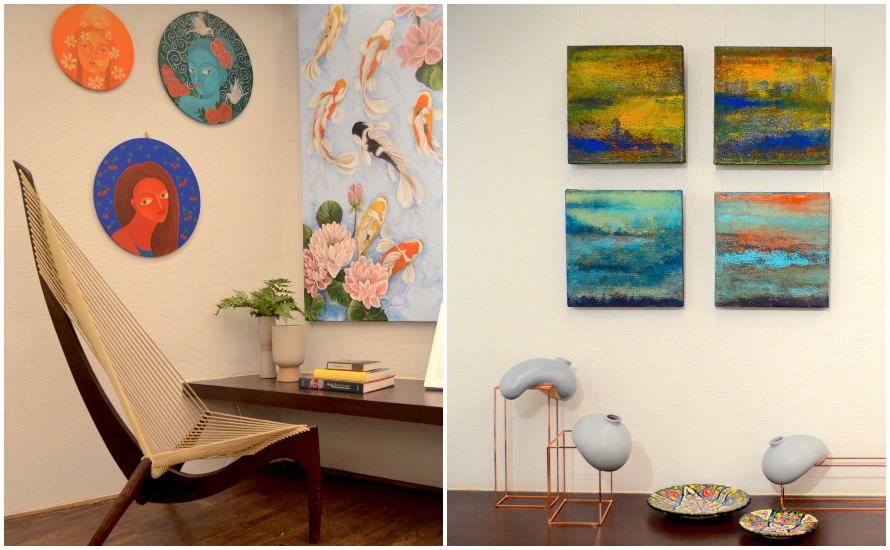Sharan Apparao takes us on a journey into the past and tells us how history coexists with art.
One sometimes misses where history meets art and what makes it imperative for the two to coexist. History is a narrative and chronicle of time, while art is an expression that communicates ideas. Ideas of today are history of the future.
Looking back from time immemorial, man expressed and surrounded himself with his findings to record and perhaps remind himself of occurrences in cave drawings and went on to create more such documentations as time went on. Some of the most important facts of social life are gleaned from adornments of architectural edifices that early men have left. Be it the inscriptions of the rock cut caves, the Jataka tales on the Vedikas (railings) of the Sanchi Stupa, the endless bands of calligraphic inscriptions in ancient mosques, or the beautiful mosaics of the European churches, they have left us with records that leave few doubts on what they were.
[wzslider autoplay=”true” lightbox=”true”]
Dictums from rulers, important events, praises of heroes and unfolding beliefs were all part of a documentation of the narratives that made what has become history to us today. This illustration of records gives us a glimpse into the realities and ideas of the past. It is this narrative of ideas that allowed artisans, craftsmen and chroniclers to find a platform to work from.
And yes, it is this very narrative that was impregnated with great beauty that brought us to the world of aesthetics. In India the text of aesthetics was written to guide these wonderful creators and this, “The Shilpa Shastra” went onto become the historical code of aesthetics in the country.
So history was the reason for artistic expression.
Today we no longer need to tell people how a carpenter’s son became a messiah and created a religion that has become a lifestyle or how a prince renounced his kingdom to look for the meaning of life, found it under the Bodhi tree and went on to conquer the world with peace. The Mahabharata and Ramayana brought the values of Dharma to us in its many complexities. These were all real events and it was the recording and rendering of these narratives in architectural adornments, illustrated manuscripts, brilliant frescoes etc. that have communicated, converted and controlled our thinking, beliefs and lives. History, Religon and Art were thus related.
Today artists have moved to new mediums to express their individuality, their personal narrative that will make a collective document of our times. History is the past; politics is the current process of government that in the future will become history. Gandhi, Nehru and Jinnah may have, in their level of evaluation, created a system of two countries that is India and Pakistan; a history that has played itself out in many artists’ platforms, while ideas of religious changes were illustrated by some others.
If Reddappa Naidu illustrated the Mahabharata in his canvases, and Nainsukh talked of life in the small kingdom of an unknown king Balwant Singh in his miniatures, and Satish Gujral told us stories of partition in his canvases and Vivan Sundaram illustrated the atrocities of the emergency and the ineffable Amar Kanwar used cinema to share his views on industrialisation of forests in his installation of “The Sovereign Forest”, they then became chroniclers of our times.
The difference between history’s artists and today’s artists is that there is a freedom of thought that has encouraged individual expression, communication and documentation in a more personal point of view whereas the past that has survived is more collective in its ideology. Today’s artists are encouraged to narrate their own ideas. They are in the process of creating epics of their own that not only will be a record but perhaps a catalyst of provocative tools to instil values and ideas and may someday influence thinking with the power of their images. Benitha Perciyal is a process driven artist who involves herself with natural materials not because she is keeping herself occupied with the craft of her creation, but because she cries out about the rape of the environment, just as Amar Kanwar does in his lyrical, poetic series of films that are part of tales that make you want to rescue the voiceless, virginal forests of Orissa from the mining concessions being given by unscrupulous politicians.
The artists of the past have helped us realise that the protests seen in the art of today is activism to shock one into waking up and preserving humanity for the future. Activism is today’s narrative and tomorrow’s history.
Yes, history meets art in a differently evolved platform, but perhaps it creates a better understanding of the present, if we choose the point of view that can help is look into the future.






 Raashii Khanna
Raashii Khanna










